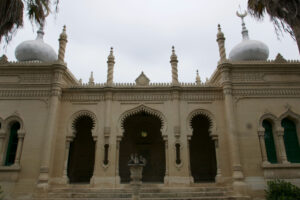Fabian Riesinger (European University Institute, Florence, department of History and Civilisation)
Imagining Rhodes and Fashioning Malta: Interconnectivity and Appropriation after 1600

Neo-Moorish monument at the Turkish Military Cemetery in Marsa, Malta. It is a cenotaph as no tombs exist within. Photograph by Sophia Hackel on April 15, 2022.
My PhD project examines the relationship between the islands of Rhodes and Malta from 1600 to 1800. The political use of the term relationship might conjure up images of a supposed civilisational divide: Rhodes, a maritime hub for the Ottoman Empire, facing Malta, the spearhead of Latin Europe. The project, however, delves into how the islands’ populations might have been unwittingly connected long after Rhodes became Ottoman in 1522 and its former occupants, the Knights of St. John, took up quarters on Malta in 1530. The focus lies on the experience of slaves and exiles, moved, and removed both internally in the Ottoman Empire and the Latinate world as well as in between. Ultimately, a series of relevant case studies reveals the patterns of movement linking the eponymous islands. Here, Ottoman bureaucratic sources intertwine with passionate poems in Italian about treacherous Turks trying to topple the Grand Master of Malta. While diverse concepts of unfreedom structure the project, the two leading approaches to the cases themselves pertain to the history of (forced) migration and the study of (sacral) architecture as a reflection of imperial entitlement and the human life contained within.
At the Orient-Institut, I aim to complete my collection of Ottoman sources at the various Istanbul-based archives and libraries. With the city as the field itself, I will be able to investigate architectural heritage contemporary to my case studies. This allows me to draw meaningful comparisons with Ottoman Rhodes but also with the Latinate cityscapes of the same period.
